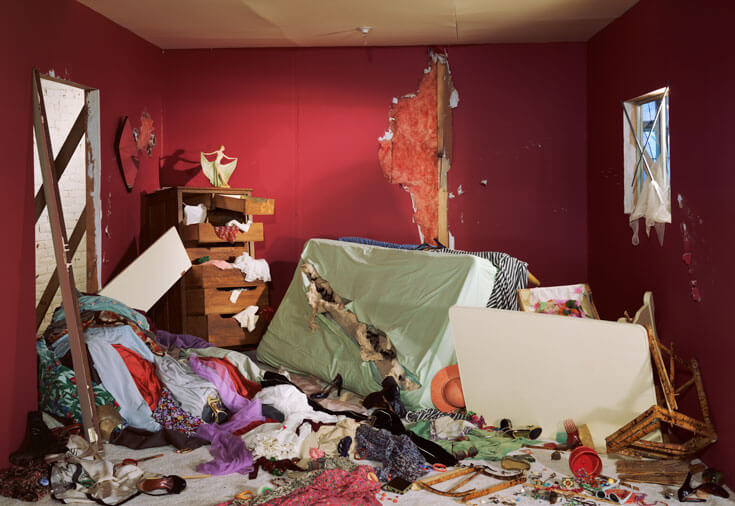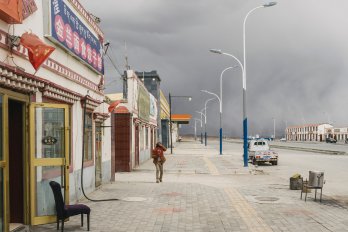Since the late 1970s, Jeff Wall has been synonymous with backlit, large-scale photographs. Though his works have never maintained the same theme or genre, he has an unmistakable style: whether he is exploring gender and relationships, war, or imagined scenes from literature, his images have a subtle and sometimes humorous poetry.
Consider 1992’s Dead Troops Talk (A Vision after an Ambush of a Red Army Patrol, Near Moqor, Afghanistan, Winter 1986): the photograph depicts a group of soldiers who have come back to life to despair and taunt one another from beyond the grave. It is a macabre panorama, and at over two metres by four metres, the scale makes the suffering of these newly dead men seem intimate. In 2012, it was bought at auction for $3,666,500 (US), making it, at the time, the third most expensive photograph ever sold. Another of Wall’s epics, After “Invisible Man,” by Ralph Ellison, the Prologue (2000), shows the narrator from Ellison’s novel sitting in his basement suite installed with 1,369 lights—the backlit format gives the bulbs a radiant effect. Along with the work of American photographer Cindy Sherman and German Andreas Gursky, Wall’s meticulously composed images, which nod to masterpieces from art history, helped put photography on equal footing with other forms of classic and contemporary art.
And so, one afternoon this past April, I walked to the Gagosian Gallery on West Twenty-First Street in New York to see what Wall, now seventy-three, had in store for his first exhibition of new work in four years. Most of the nine prints exhibited were signature Wall. The diptych Summer Afternoons presents two images of what appears to be the same room (a recreation of Wall’s former home): one with a nude male lying on the floor, back to camera, the other with a woman reclining on a daybed, not unlike the courtesan in Édouard Manet’s Olympia. The triptych Giardini/The Gardens, meanwhile, seems to depict the firing of a servant at an Italian villa, each print illustrating a different point in the process. It marks the first time Wall has ever created a series that tells a continuous narrative, yet The Gardens, like all of his images, only offers pieces of the story’s puzzle.
My eye, however, was immediately drawn to the enormous picture in the middle of the main wall: the Day-Glo Recovery. It wasn’t like anything Wall had ever made. At first glance, Recovery may seem like a painting of loungers and picnickers at a park. Unlike Wall’s typical realism, the scene is a barrage of brilliant colours: the ground is yellow, the tree trunks are cyan and persimmon, and the hills in the background are a light mauve. There is an otherworldly quality to the image, reminiscent of David Hockney or Henri Matisse. In the centre of the menagerie is a young man. His left leg, left arm, and shoes are of the same painterly quality as the rest of the picture, but the remainder of his body is that of a normal, photographed person. He stares off into the distance, looking dazed and bewildered, somehow appearing more unreal than all the pigmented people around him. Only on close consideration does it become clear that the artist, who has spent nearly four decades making photographs with an eye for the history of painting, has advanced that project to a bizarre new level by taking a picture of a painting.
At first glance, Recovery may seem primed for the selfie generation. At about 2.5 metres by four metres, its size and brilliant colours can make it seem like trite pop art—something that would make for a nice background on a social-media post. This may be why reaction to the image has been mixed. As I stood in front of Recovery, another guest walked up to join me. “That fucking thing,” they said before walking away. Later, Karen Rosenberg, writing for the New York Times, called the work “a bold move, with an uncertain payoff” and further criticized Recovery for bringing to mind “Instagrammers posing in front of street art.”
But Recovery proves to be something more. Wall has been a consistent critic of contemporary visual culture throughout his career and has often tested the possibilities of what photography could be. Over the decades, he has constantly reinvented his work and how he approaches his craft, prodding us to see the world, and his chosen medium, in a new way. Recovery is not an aberration when measured against the rest of Wall’s oeuvre; all appearances aside, it’s a perfect fit.
Jeff Wall’s fascination with modern art dates back to childhood. As a teenager in Vancouver, he travelled to Seattle’s 1962 World’s Fair and saw an exhibition that included work by Jackson Pollock. In 1968, he graduated from the University of British Columbia with a degree in fine arts and, after starting out as a painter, took an interest in conceptual art. Two years later, he exhibited Landscape Manual at the Museum of Modern Art in New York. This early piece took the form of a booklet that combined documentary photography and text. Following that achievement, he ceased exhibiting, instead studying art history at London’s Courtauld Institute.

When Wall returned to his own practice, in 1976, it was as a photographer. Two years later, he exhibited The Destroyed Room in the window of Vancouver’s Nova Gallery and arrived as an artist. The Destroyed Room is a photograph that looks like its name: a pea-green mattress is torn open and thrown against a carmine wall; the drawers of a dresser are open and ransacked, their contents scattered across the floor. Within the unruly mess of broken walls and upended furniture, the composition references Eugène Delacroix’s 1827 masterpiece The Death of Sardanapalus. Through an open door on the edge of the mise en scène in Wall’s work, the viewer can see that the image is a stage set—the artifice part of the picture. Perhaps the most notable thing about the photograph was how it was displayed: in a light box, reminiscent of an outdoor advertisement. These Cibachrome, backlit transparencies soon became Wall’s signature—the use of fluorescent lights managing to be simultaneously captivating and crass.
Wall’s photographic tableaux were critical, complex, and pleasing to the eye. Perhaps unexpectedly, these radiant scenes and the light boxes he displayed them in were received as punk-like provocations, contradicting the art-world orthodoxy that pictures could not be critical of the systems in which they circulated. (It makes sense that, years later, Wall photographed Iggy Pop for one of the singer’s album covers, and The Destroyed Room was used as the cover for a collection of Sonic Youth B-sides.) Here were the old masters as modern ads.
Wall quickly proved himself a pioneer in other ways. He was one of the first artists of his generation to use movie production methods to stage his shots (from The Destroyed Room onward, his pictures have been taken on meticulously constructed sets, using crews and models). Wall was also at the vanguard of artists who digitally altered their images, and starting in the early 1990s, his tableaux became composites of numerous photographs taken during production. For example, A Sudden Gust of Wind (after Hokusai), based on an 1832 Hokusai woodblock print, depicts a group of people along a canal: the wind has just scattered a dossier of papers into the air, and four figures in the foreground struggle against the gale. The central figure, a man in a suit, looks to the sky to see a hat hurtling toward the heavens. Instead of capturing what Henri-Cartier Bresson called “the decisive moment” or following the street-photography methods made famous by the likes of Walker Evans, Robert Frank, and Diane Arbus, Wall planned his way to precise, deliberate pictures such as this. A Sudden Gust of Wind was rehearsed, shot, and shot again before being digitally collated to bring together the final image.
Wall’s style of photography was a critical and commercial success, and he has since had retrospectives at the Museum of Modern Art in New York, the Chicago Art Institute, the Tate Modern in London, the Henri Cartier-Bresson Foundation museum in Paris, the Stedelijk in Amsterdam, and the Louisiana in Denmark. He received Sweden’s prestigious Hasselblad Award in 2002 and the Order of Canada in 2007.
By that year, he could have easily put his production on autopilot and churned out light box after light box, making certain collectors and vendors very happy. (Wall’s large-scale light boxes can cost hundreds of thousands of dollars on the secondary market; major works go for the low millions.) Instead, when we encounter a Wall work produced after 2007, there is no radiance from fluorescent tubes: rather than retreat into repetition, he ditched his signature format altogether and began producing large prints. He has rarely spoken about the reasons for this change, but it is worth noting that the light box had morphed into a common way of viewing large-scale photography.
Few critics remarked on this departure at the time, but the shift was telling: Wall has always refused certain financial pressures and cultural trends, working instead with an eye on aesthetic goals. His risky return to painting in Recovery is no different.
In on late style: Music and Literature against the Grain, literary critic Edward Said discusses the idea that age imbues some artists with wisdom and others with stubbornness. He gives the examples of Matisse, Bach, and Wagner, all of whom have later works he claims reflect harmoniously on life. “But what of artistic lateness,” Said continues, “not as harmony and resolution but as intransigence, difficulty, and unresolved contradiction?”
Recovery seems to be a culmination of Wall’s post–light box output, and it is certainly “intransigence, difficulty, and unresolved contradiction” in Said’s sense. Wall could have exhibited the painting (and maybe even sold it for a considerably greater sum), but he didn’t. In Recovery, after we understand that it’s a photograph of a painting, the half-real, photo-montaged man further disrupts the harmony of the reverie. The formal disjunction is unsettling, a reminder that the picture we’re looking at is not only an illusion but also an affront to our expectations.
The sheer size of Wall’s work also compromises gallery goers’ attempts to capture it fully on Instagram (something I realized myself on opening night). With Recovery, what might at first seem like a capitulation to selfie culture is another refusal: get too close and you miss the entirety of the image; stand too far back and you lose the detail. Like with Dead Troops Talk, each viewing reveals more richness: sections of Recovery contain miniature compositions (take the man in the towel with two dogs: each grouping of human and animal figures hints at its own story). This depth is yet another example of how Wall’s images may initially seem to conform to the commercial but, on reflection, do the opposite. As David Campany wrote in the Financial Times, reviewing the same Wall material when it appeared at London’s White Cube Gallery this summer: “If there is one photographer who has championed slow looking and an art of fewer but better images, it is Jeff Wall.”
Yet, amid all this seriousness, Wall still shows his sense of humour. At the Gagosian, a self-reflexive wink came in the placement of the black-and-white Weightlifter (2015) on the wall opposite Recovery. Weightlifter depicts a sweaty, muscular man struggling to lift 100-odd kilograms in a gym. The strain on the model’s face shows the pain, focus, and determination going into the feat. Even so, we’re uncertain if he ever succeeds.



